ISSN ONLINE(2319-8753)PRINT(2347-6710)
ISSN ONLINE(2319-8753)PRINT(2347-6710)
T. Nataraja Moorthy1 and Hafizah Harun2
|
| Related article at Pubmed, Scholar Google |
Visit for more related articles at International Journal of Innovative Research in Science, Engineering and Technology
Small plastic bags are known to have been mainly used by drug peddlers for distributing illicit drugs. This research is aimed to study the intra batch and inter-batch stability of extrusion mark pattern in transparent plastic bags i.e. the pattern of extrusion lines produced in transparent plastic bags during manufacturing process. The plastics bags were purchased as packets in retail outlets and collected from a consented plastic manufacturing factory in the known machine. The result of the study on extrusion mark pattern presented here relates to the comparison of the characteristic extrusion line pattern in plastic bags belonging to the same batch as well as different batches over a period of one year. The results indicated that extrusion mark pattern in the plastic bags revealed stability both on intra batch as well as inter-batch basis that can be useful for establishing the origin.
Keywords |
| Forensic science, Transparent plastic bags, Extrusion mark pattern, Intra and inter-batch, Establishing the origin. |
I. INTRODUCTION |
| Plastic and garbage bags form frequent evidence in different types of crime [1-5]. Smaller plastics bags are commonly used as packing material in drug crime [1,2] while larger garbage bags have been used as packing material for parts of human bodies in murder cases [3]. A common question that rises in connection with plastic bag as evidence is “Does the questioned plastic bag and the plastic bags recovered from the suspects’ premises originate from the same source”?. Although various types of marks in the plastic bags have been used for comparison purposes, specific studies for attributing the origin of a plastic bag to a batch of plastic bags have not been carried out so far. This research addresses the reliability of using extrusion mark pattern for attributing the transparent plastic bags to the same batch in a packet, in addition to establishing the retention of these extrusion mark pattern in the transparent plastic bags of different batches from the same machine in a consented plastic bags manufacturing factory. |
II. BACKGROUND |
| Transparent plastic bags are manufactured by a blown film extrusion technique (Fig.1) wherein colorless polythene beads (Fig.2) are subjected to melting at a temperature of 2000C [2] and blown into long, tubular plastic rolls through a circular die (Fig.3 & Fig.4) and then cut and sealed into suitable sizes of bags [1]. The marks that have been mainly formed and examined in this regard include extrusion marks or extrusion lines [1-6], the marks from the cutting tools [1-5] and sealing marks [4,6,7]. Researches have been conducted for enhancing the visibility of some of the marks which are almost invisible [2-3]. The extrusion mark pattern caused by the dye ring is fingerprint characteristics to a particular dye ring. |
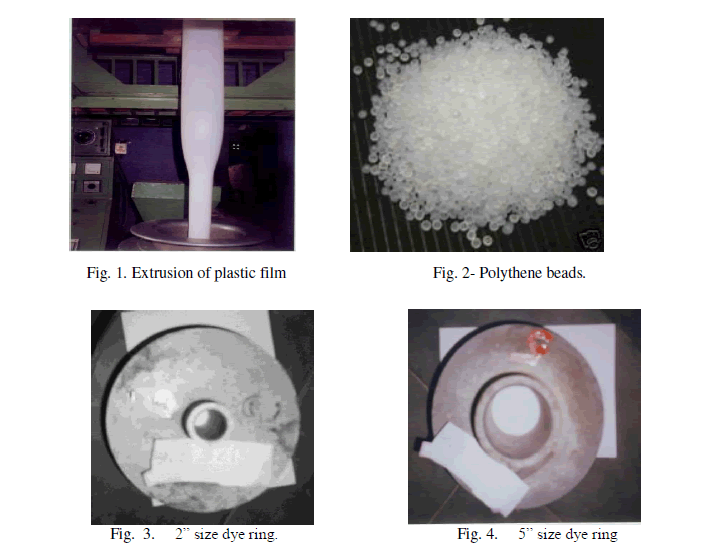 |
| It has been realized that there has been an increase in drug trafficking cases received in forensic science laboratories and in many cases, a supplier divides the drugs into small amounts and repackages them using plastic bags and then sells them to the users [2]. In such instances, comparison of the packaging with plastic bags or cling films from the supplier often provides evidence to substantiate a charge of supplying the drugs. It has also been realized that smaller plastic bags are very commonly used as packing material in drug crimes while garbage bags are used for packaging parts of human bodies. A common question is; “Does the plastic bag came from this roll of bags?” [4]. Although different types of marks caused during the production process have been considered for analysis, the extrusion marks play an important role in the comparison and subsequent linking of plastic bags [3]. |
| Review of literature reveals that the specific question of attributing one plastic bag to a particular batch of bags commonly sold as a packet in retail shops has not been addressed by the researchers so far. In a practical crime related situation wherein the plastic bags recovered from the possession of one or many drug addicts are required to be linked with each other or with a set of bags recovered from the distributor, there has to be specific research finding on the extent of the reliability of using the marks in the plastic bags for establishing such common origin. This research, for the first time addresses the reliability of using extrusion marks for attributing the plastic bags to the same batch in a packet, in addition to establishing the retention of these extrusion marks in the plastic bags of different batches from the same machine. |
III. MATERIALS AND METHODS |
| The transparent plastic bags that formed the material of the study were obtained from two sources. First, from a consented manufacturer, Alpha Pack (M) Sdn. Bhd, Ampang, Selangor, Malaysia from whom transparent plastic bags in multiple batches extruded from the identifiable machines were periodically obtained for 12 months. Second, multiple batches of plastic bags sold as packets were purchased from various retail outlets. A “batch” is considered as composing of multiple number of individual plastic bags packed in the same packet when purchased from a retailer or as a long tube (2 to 10 feet) of blown plastic in which areas revealing extrusion mark pattern in different locations can be marked when such long plastic tubes are purchased from the manufacturer. In the former, the individual bags were numbered serially while in the latter, different locations were serially numbered and marked; the entire series in each case forming one batch. |
| Each set of tubes collected on a particular date was considered a batch and the extrusion mark pattern in one batch i.e. intrabatch extrusion mark pattern, were compared with the extrusion mark pattern seen on the tubes belonging to the other batches during inter-batch comparison. Thus inter batch comparison can be between the tubes manufactured from the machine on the same or different days as well as between the tubes from different machines on the same or different days. The plastic tubes from the manufacturer were obtained on monthly basis.Analysis relating to evaluating the stability of the extrusion mark pattern in the different areas in the length of a blown plastic tube manufactured on a known date from a known machine or in the different bags in one packet from a retail outlet is designated as an intra-batch analysis. This stability was ascertained by comparing the different areas in the length. The extent of correlation among the extrusion line pattern were visually evaluated in enlarged images of plastic bags generated using Over Head Projector (Spectra 1000 S) and the marks were recorded as photographs. |
IV. EXPERIMENTAL RESULTS |
| Extrusion mark patterns found in different transparent plastic bags from different sources showed strikingly varying patterns (Fig 5a-5d). The extrusion mark pattern were found to correlate with each other in multiple parts of the length of plastic tube manufactured using a particular machine on a specific date (Fig 6) as well as in the different plastic bags found packed in the same packet purchased from the retail outlet (Fig.7), establishing that there is reliable intra-batch stability of extrusion mark pattern that can enable definite attribution of a plastic bag to its origin on an intra-batch basis. |
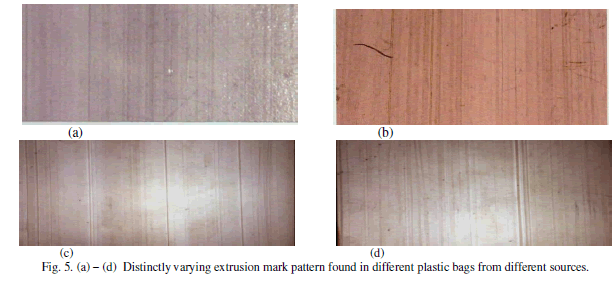 |
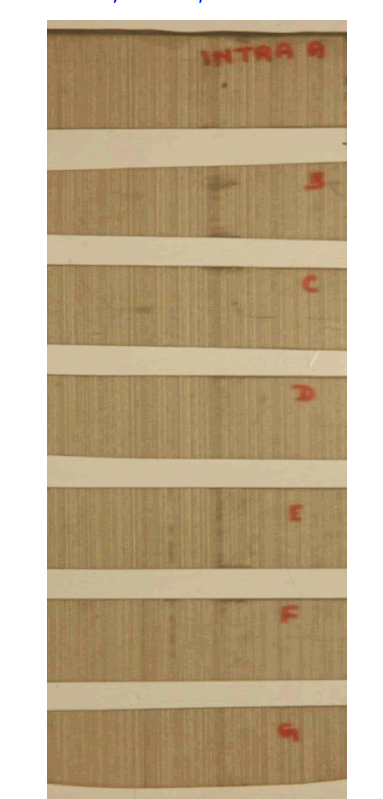 |
| Fig. 6. Intra batch stability of extrusion mark pattern in the different areas in the length of a blown plastic tube manufactured on a known date from a known machine |
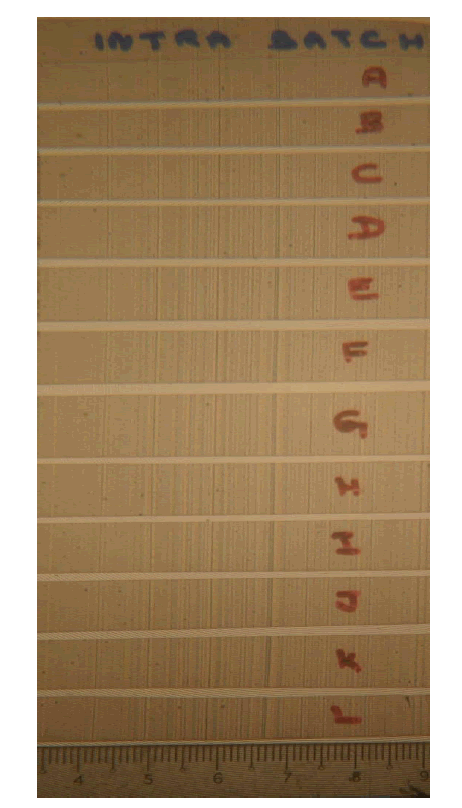 |
| Fig. 7. Intra batch stability of extrusion mark pattern among the samples of plastic bags sold in a packet. |
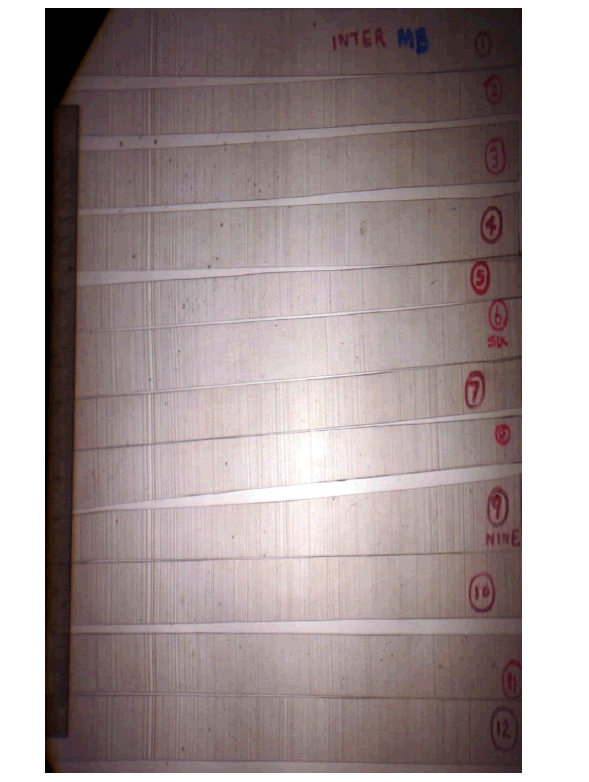 |
| Fig. 8. Inter-batch stability of extrusion mark pattern in the samples of transparent plastics from the same known machine No.1 collected in 12 months (sample nos. 1/1 to 1/12). |
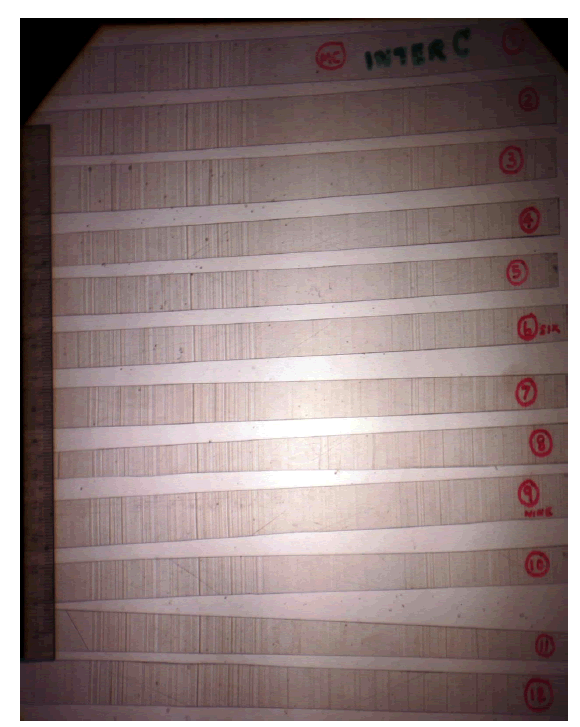 |
| Fig. 9. Inter-batch stability of extrusion mark pattern in the samples of plastics from the same known machine No.2 collected in 12 months (sample nos. 2/1 to 2/12) |
| It was also found that the extent of correlation between the extrusion mark pattern of different batches represented by different locations in the lengths of plastic tubes manufactured on different months but using the same machine (samples collected in machine No.1 and No.2) with the same dye also retained the stability (interbatch stability) in correlation (Fig.8 & 9), reiterating the reliability in using extrusion mark pattern for comparison of plastic bags for assigning origin. But no two machines have the same extrusion mark pattern. |
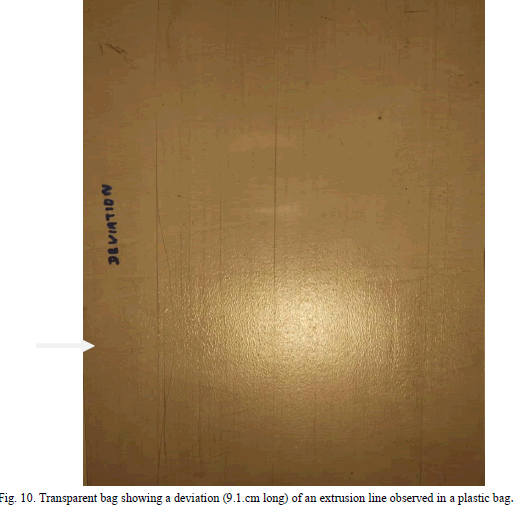 |
| As a rule, the extrusion marks or lines are straight running parallel to each other along the length of the plastic bag or tube. Deviation from the straight course has also been observed (Fig.10). Whenever there is a deviation, the deviating extrusion mark was found to run away from the straight extrusion mark taking a skewed course to distances varying from a few centimeters to more than a meter. However, at the end of the deviation such skewed marks were always found to converge along the straight marks resuming the parallel course. The reason for such deviation may be due to the fluctuation in the pressure of the blower in the manufacturing process. Also another interesting feature observed in the inter batch samples was that some of the running lines in a pattern found disappeared in samples of certain months but reappeared subsequently. Anyhow most of the lines in the pattern were found throughout the period of inter-batch collection. The results of this research, for the first time, indicate that the extrusion marks can be reliably used for correlating plastic bags that originated from the same packet, here referred to as ‘batch’. Furthermore, the extrusion marks are found to be stable for as long a period as 12 months as long as the machine and the dye remain unchanged. |
V. DISCUSSIONS |
| The evaluation of the extrusion mark pattern and the extent of their correlation in intra-batch specimens as well as interbatch specimens were made by visual assessment of these marks using an enlarged image of the pieces in corresponding areas of plastic from different plastic bags using an overhead projector. Such intrabatch and inter-batch studies of transparent plastic bags have not been carried out by earlier researchers. Although several methods have been suggested for enhancing the visibility of extrusion marks, as would be evident from the Figures 5-10 that OHP generated enlarged images are sufficient for evaluating the correlation between the extrusion marks in transparent plastic bags. It was also observed that as the thickness of the transparent plastic bag increases, the clarity of the extruded lines pattern was prominent in the overhead projector. Extrusion mark pattern have been found useful while comparing transparent plastic bags [1-3, 5-6]. |
VI. CONCLUSIONS |
| Transparent plastic bags are prevalently used by drug abusers and, at times by criminals for disposal of human body parts etc. Extrusion marks have already been indicated as a useful tool for examining plastic bags. In conclusion, the results of this research, for the first time, indicate that the extrusion mark pattern caused by a particular dye can be reliably used for correlating plastic bags that originated from the same packet, here referred to as ‘batch’. Furthermore, the extrusion mark patterns are found to be stable for as long a period as 12 months whenever the machine and the dye remain unchanged. Thus, the findings of this research can be useful in establishing common origin of plastic bags recovered from varying sources such as from different drug addicts, different regions and a particular source of origin. |
VII. ACKNOWLEDGEMENT |
| Sincere acknowledgement is due to Mr. B.B. Tan, General Manager, Alpha Pack (M) Sdn, Bhd, Ampang, Selangor Darul Ehsan, Malaysia for permitting the authors to visit to the factory, and periodically supplied the plastic bags for this research. Acknowledgements are due to Mr. S. William and Mr. Amir Shaharuddin Bin Mohamad Hassan, Lanjut Pertiwi Sdn Bhd, Kuala Lumpur, Malaysia who were kind enough to coordinate the sample collection in all the various stages. Sincere acknowledgement is due to Universiti Sains Malaysia for the support to conduct this research project. |
References |
|